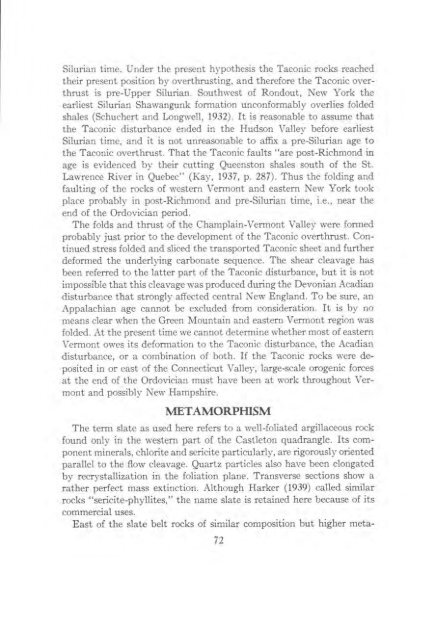STRATIGRAPHY AND STRUCTURE CASTLETON AREA VERMONT
STRATIGRAPHY AND STRUCTURE CASTLETON AREA VERMONT
STRATIGRAPHY AND STRUCTURE CASTLETON AREA VERMONT
Create successful ePaper yourself
Turn your PDF publications into a flip-book with our unique Google optimized e-Paper software.
Silurian time. Under the present hypothesis the Taconic rocks reached<br />
their present position by overthrusting, and therefore the Taconic overthrust<br />
is pre-Upper Silurian. Southwest of Rondout, New York the<br />
earliest Silurian Shawangunk formation unconformably overlies folded<br />
shales (Schuchert and Longwell, 1932). It is reasonable to assume that<br />
the Taconic disturbance ended in the Hudson Valley before earliest<br />
Silurian time, and it is not unreasonable to affix a pre-Silurian age to<br />
the Taconic overthrust. That the Taconic faults "are post-Richmond in<br />
age is evidenced by their cutting Queenston shales south of the St.<br />
Lawrence River in Quebec" (Kay, 1937, p. 287). Thus the folding and<br />
faulting of the rocks of western Vermont and eastern New York took<br />
place probably in post-Richmond and pre-Silurian time, i.e., near the<br />
end of the Ordovician period.<br />
The folds and thrust of the Champlain-Vermont Valley were formed<br />
probably just prior to the development of the Taconic overthrust. Continued<br />
stress folded and sliced the transported Taconic sheet and further<br />
deformed the underlying carbonate sequence. The shear cleavage has<br />
been referred to the latter part of the Taconic disturbance, but it is not<br />
impossible that this cleavage was produced during the Devonian Acadian<br />
disturbance that strongly affected central New England. To be sure, an<br />
Appalachian age cannot be excluded from consideration. It is by no<br />
means clear when the Green Mountain and eastern Vermont region was<br />
folded. At the present time we cannot determine whether most of eastern<br />
Vermont owes its deformation to the Taconic disturbance, the Acadian<br />
disturbance, or a combination of both. If the Taconic rocks were deposited<br />
in or east of the Connecticut Valley, large-scale orogenic forces<br />
at the end of the Ordovician must have been at work throughout Vermont<br />
and possibly New Hampshire.<br />
METAMORPHISM<br />
The term slate as used here refers to a well-foliated argillaceous rock<br />
found only in the western part of the Castleton quadrangle. Its component<br />
minerals, chlorite and sericite particularly, are rigorously oriented<br />
parallel to the flow cleavage. Quartz particles also have been elongated<br />
by recrystallization in the foliation plane. Transverse sections show a<br />
rather perfect mass extinction. Although Harker (1939) called similar<br />
rocks "sericite-phyllites," the name slate is retained here because of its<br />
commercial uses.<br />
East of the slate belt rocks of similar composition but higher meta-<br />
72













